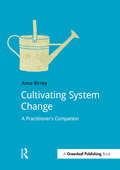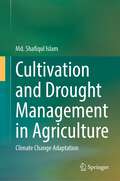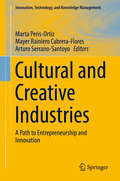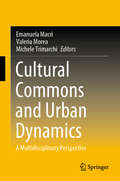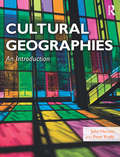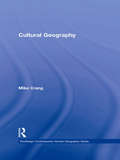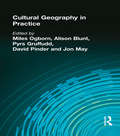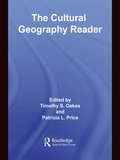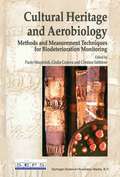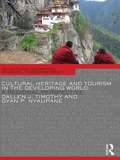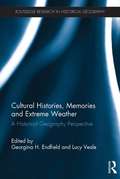- Table View
- List View
Cultivating System Change: A Practitioner’s Companion
by Anna BirneyWhere should you start if you are faced with massive systemic challenges or want to cultivate a shift towards sustainability in global systems? Where are the leverage points for systemic change? This book provides examples of what organizations and companies like the Sustainable Shipping Initiative, WWF and Nike are doing, along with practical strategies and an overview of system change theory. Section one outlines systems thinking, especially how we can use a "living systems" perspective as a tool to understanding sustainability and change.Section two pulls out practical strategies for action from theoretical models and "must-read" literature. Section three illustrates how organisations are implementing these strategies – including examples from the Sustainable Shipping Initiative, Nike, Sustainable Food Lab, Finance Innovation Lab, Shell Foundation and Rockefeller Foundation.Section four provides tips for you as a practitioner navigating this territory. Many of the ideas behind cultivating system change can be difficult to understand until they are put into practice. This "practitioner's companion" ends with questions that will prompt reflections and spur you to action. Keep it to hand as you change the system!
Cultivating System Change: A Practitioner’s Companion (Doshorts Ser.)
by Anna BirneyWhere should you start if you are faced with massive systemic challenges or want to cultivate a shift towards sustainability in global systems? Where are the leverage points for systemic change? This book provides examples of what organizations and companies like the Sustainable Shipping Initiative, WWF and Nike are doing, along with practical strategies and an overview of system change theory. Section one outlines systems thinking, especially how we can use a "living systems" perspective as a tool to understanding sustainability and change.Section two pulls out practical strategies for action from theoretical models and "must-read" literature. Section three illustrates how organisations are implementing these strategies – including examples from the Sustainable Shipping Initiative, Nike, Sustainable Food Lab, Finance Innovation Lab, Shell Foundation and Rockefeller Foundation.Section four provides tips for you as a practitioner navigating this territory. Many of the ideas behind cultivating system change can be difficult to understand until they are put into practice. This "practitioner's companion" ends with questions that will prompt reflections and spur you to action. Keep it to hand as you change the system!
Cultivation and Catastrophe: The Lyric Ecology of Modern Black Literature (The <I>Callaloo</I> African Diaspora Series)
by Sonya PosmentierAt the intersection of social and environmental history there has emerged a rich body of black literary response to natural and agricultural experiences, whether the legacy of enforced agricultural labor or of the destruction and displacement brought about by a hurricane. In Cultivation and Catastrophe, Sonya Posmentier uncovers a vivid diasporic tradition of black environmental writing that responds to the aftermath of plantation slavery, urbanization, and free and forced migrations. While humanist discourses of African American and postcolonial studies often sustain a line between nature and culture, this book instead emphasizes the relationship between them, offering an innovative environmental history of modern black literature. Posmentier argues that environmental experiences of growth and rupture define the literature of black freedom, an archive that ranges from sonnets, mini-epics, documentary poems, periodicals, and novels to blues songs, dancehall productions, and ethnographic writing. In turn, this literature generates important and surprising models for ecological thought. Claude McKay, for example, connects rows of potatoes to the poetic line; Zora Neale Hurston composes rhythmic communal lyrics in the Florida "muck" following a deadly hurricane; and Derek Walcott critiques property-based ecological relations through the archipelagic shape of his mid-career poetry. Posmentier examines how these writers, along with Gwendolyn Brooks, Bessie Smith, Sterling Brown, Lloyd Lovindeer, Kamau Brathwaite, and others give voice to racialized experiences of alienation from the land while simultaneously envisioning a modern poetics of survival, repair, and generation. Going against the grain of scholarship that has situated modern black diasporic agency largely in metropolitan sites, Posmentier traces a black literary history of environmental and social disaster while exploring the possibilities and limits of poetry as an archive for black modern culture in its many forms. This pathbreaking book offers stunning new insight into modern black literature, environmental humanities, and poetry and poetics.
Cultivation and Catastrophe: The Lyric Ecology of Modern Black Literature (The <I>Callaloo</I> African Diaspora Series)
by Sonya PosmentierAt the intersection of social and environmental history there has emerged a rich body of black literary response to natural and agricultural experiences, whether the legacy of enforced agricultural labor or of the destruction and displacement brought about by a hurricane. In Cultivation and Catastrophe, Sonya Posmentier uncovers a vivid diasporic tradition of black environmental writing that responds to the aftermath of plantation slavery, urbanization, and free and forced migrations. While humanist discourses of African American and postcolonial studies often sustain a line between nature and culture, this book instead emphasizes the relationship between them, offering an innovative environmental history of modern black literature. Posmentier argues that environmental experiences of growth and rupture define the literature of black freedom, an archive that ranges from sonnets, mini-epics, documentary poems, periodicals, and novels to blues songs, dancehall productions, and ethnographic writing. In turn, this literature generates important and surprising models for ecological thought. Claude McKay, for example, connects rows of potatoes to the poetic line; Zora Neale Hurston composes rhythmic communal lyrics in the Florida "muck" following a deadly hurricane; and Derek Walcott critiques property-based ecological relations through the archipelagic shape of his mid-career poetry. Posmentier examines how these writers, along with Gwendolyn Brooks, Bessie Smith, Sterling Brown, Lloyd Lovindeer, Kamau Brathwaite, and others give voice to racialized experiences of alienation from the land while simultaneously envisioning a modern poetics of survival, repair, and generation. Going against the grain of scholarship that has situated modern black diasporic agency largely in metropolitan sites, Posmentier traces a black literary history of environmental and social disaster while exploring the possibilities and limits of poetry as an archive for black modern culture in its many forms. This pathbreaking book offers stunning new insight into modern black literature, environmental humanities, and poetry and poetics.
Cultivation and Drought Management in Agriculture: Climate Change Adaptation
by Md. Shafiqul IslamThis book represents the background of the Barind Tract of Bangladesh with the proximity of drought information, conceptual and logic of the books, history, definition and perception on drought and climate scenario and how people understand underlying causes, impacts and consequences of drought in agriculture, environment, human health and society. It also states the trend and severity of drought of Barind Tract. This book gives the local response to cope, mitigation and adaptation to agricultural drought. The book also addresses the gender response in the hardship of drought in the rural areas. It also elicits the local and indigenous methods of drought prediction and sustainable cultivation and management of drought in agriculture.
Cultural and Creative Industries: A Path To Entrepreneurship And Innovation (Innovation, Technology, and Knowledge Management)
by Marta Peris-Ortiz Mayer Rainiero Cabrera-Flores Arturo Serrano-SantoyoThis book examines the ways in which cultural and creative industries can drive entrepreneurship, innovation, sustainability and overall regional development. It will address such issues as (1) the technical (tangible) components of creative and cultural industries in relation to innovation; (2) the intangible components of creative and cultural industries in relation to services provided; (3) the relationship between tangible and intangible components and economic and social innovation; and (4) the ways in which creative and cultural industries effect and influence regional sustainability and development.Cultural and creative industries and the creative economy as a whole have been increasingly prevalent in research literature because of their role in driving economic and social development. Cultural and creative industries also enable other forms of entrepreneurship and innovation beyond the traditional, technology-based focus of innovation, thereby enhancing regional growth and development through these channels. The contributions presented in this book discuss the main issues, challenges, opportunities and trends of cultural and creative industries through conceptual analysis and cases studies from different world regions. Featuring research from industries such as art, health care, beer and wine and education, this book provides researchers, academics, professionals and policy makers with a detailed examination of the development and potential of cultural and creative industries in regional and global economies.
The Cultural and Political Intersection of Fair Trade and Justice: Managing a Global Industry
by Tamara L. StennThe Cultural and Political Intersection of Fair Trade and Justice is an ethnographic study of the effects of Fair Trade on indigenous women, as reported by the women themselves, and seeks to develop a deeper understanding of Fair Trade, globalization, culture, and policy in building justice.
Cultural Commons and Urban Dynamics: A Multidisciplinary Perspective
by Emanuela Macrì Valeria Morea Michele TrimarchiToday, cities are being intensively reshaped by unexpected dynamics. The rise and growth of the digital economy have fundamentally changed the relationship between the urban fabric and its resident community, overcoming the conventional hierarchy based on production priorities. Moreover, contemporary society discovers new labour conditions and ways of satisfying needs and desires by developing new synergies and links. This book examines cultural and urban commons from a multidisciplinary perspective. Economists, architects, urban planners, sociologists, designers, political scientists, and artists explore the impact and implications of cultural commons on urban change. The contributions discuss both cases of successful urban participation and cases of strong social conflict, while also addressing a host of institutional contradictions and dilemmas. The first part of the book examines urban commons in response to institutional constraints from a theoretical point of view. The second and third parts apply the theories to case studies and discuss various practices of sustainable planning and re-appropriation in the urban context. In closing, the fourth part develops a new urban agenda as artists imagine it. This book will appeal to scholars interested in the social, economic and institutional implications of cultural and urban commons, and provide useful insights and tools to help local governments and policymakers manage social, cultural and economic change.
Cultural Dynamics of Water in Iranian Civilization
by Majid Labbaf KhaneikiThis book traces “water” back to the most primitive animistic notions that are still lingering on in the shape of such rituals as qanat marriage or rain-making. Water, in the Iranian philosophy, is used in an attempt to find an explanation for the genesis of the universe, as described in Zoroastrian Akhshij philosophy, according to which water is one of the four fundamental elements of the creation. The concept of time began to germinate in the Iranian mind, when they had to count the passage of time in order to divide their scarce water resources. Water became so omnipresent in Iranian culture that it reached even the most mysterious seclusion of the Sufi monks. In Iran’s local communities, water culture is a thread that runs through different types of production systems. This book goes beyond indigenous water knowledge and traditional irrigation techniques, and conceptualizes water as a pivotal element of Iran’s social identity, cultural dynamics and belief systems, where it examines the role of intermittent droughts in engendering and diffusing intangible cultural elements across the Iranian plateau. This book delves into Iran’s political organizations most of which were ensnared in a water-dependent lifecycle constituting a historical pattern described in this book as “hydraulic collapse” .
Cultural Geographies: An Introduction
by John Horton Peter KraftlCultural geography is a major, vibrant subdiscipline of human geography. Cultural geographers have done some of the most important, exciting and thought-provokingly zesty work in human geography over the last half-century. This book exists to provide an introduction to the remarkably diverse, controversial, and sometimes-infuriating work of cultural geographers. The book outlines how cultural geography in its various forms provides a rich body of research about cultural practices and politics in diverse contexts. Cultural geography offers a major resource for exploring the importance of cultural materials, media, texts and representations in particular contexts and is one of the most theoretically adventurous subdisciplines within human geography, engaging with many important lines of social and cultural theory. The book has been designed to provide an accessible, wide-ranging and thought-provoking introduction for students studying cultural geography, or specific topics within this subdiscipline. Through a wide range of case studies and learning activities, it provides an engaging introduction to cultural geography.
Cultural Geographies: An Introduction
by John Horton Peter KraftlCultural geography is a major, vibrant subdiscipline of human geography. Cultural geographers have done some of the most important, exciting and thought-provokingly zesty work in human geography over the last half-century. This book exists to provide an introduction to the remarkably diverse, controversial, and sometimes-infuriating work of cultural geographers. The book outlines how cultural geography in its various forms provides a rich body of research about cultural practices and politics in diverse contexts. Cultural geography offers a major resource for exploring the importance of cultural materials, media, texts and representations in particular contexts and is one of the most theoretically adventurous subdisciplines within human geography, engaging with many important lines of social and cultural theory. The book has been designed to provide an accessible, wide-ranging and thought-provoking introduction for students studying cultural geography, or specific topics within this subdiscipline. Through a wide range of case studies and learning activities, it provides an engaging introduction to cultural geography.
Cultural Geography
by Mike CrangFirst Published in 1998. Routledge is an imprint of Taylor & Francis, an informa company.
Cultural Geography
by Mike CrangFirst Published in 1998. Routledge is an imprint of Taylor & Francis, an informa company.
CULTURAL GEOGRAPHY IN PRACTICE
by Miles Ogborn Alison Blunt Pyrs Gruffudd David PinderCultural Geography in Practice provides an innovative and accessible approach to the sources, theories and methods of cultural geography. Written by an international team of prominent cultural geographers, all of whom are experienced researchers, this book is a fully illustrated guide to methodological approaches in cultural geography. In order to demonstrate the practice of cultural geography each chapter combines the following features:·Practical instruction in using one of the main methods of cultural geography (e.g. interviewing, interpreting texts and visual images, participatory methods)·An overview of a key area of concern in cultural geography (e.g. the body, national identity, empire, marginality)·A nuts and bolts description of the actual application of the theories and methods within a piece of researchWith the addition of boxed definitions of key concepts and descriptions of research projects by students who devised and undertook them, Cultural Geography in Practice is an essential manual of research practice for both undergraduate and graduate geography students.
CULTURAL GEOGRAPHY IN PRACTICE
by Miles Ogborn Alison Blunt David Pinder Pyrs GruffuddCultural Geography in Practice provides an innovative and accessible approach to the sources, theories and methods of cultural geography. Written by an international team of prominent cultural geographers, all of whom are experienced researchers, this book is a fully illustrated guide to methodological approaches in cultural geography. In order to demonstrate the practice of cultural geography each chapter combines the following features:·Practical instruction in using one of the main methods of cultural geography (e.g. interviewing, interpreting texts and visual images, participatory methods)·An overview of a key area of concern in cultural geography (e.g. the body, national identity, empire, marginality)·A nuts and bolts description of the actual application of the theories and methods within a piece of researchWith the addition of boxed definitions of key concepts and descriptions of research projects by students who devised and undertook them, Cultural Geography in Practice is an essential manual of research practice for both undergraduate and graduate geography students.
The Cultural Geography Reader
by Timothy Oakes Patricia L. PriceThe Cultural Geography Reader draws together fifty-two classic and contemporary abridged readings that represent the scope of the discipline and its key concepts. Readings have been selected based on their originality, accessibility and empirical focus, allowing students to grasp the conceptual and theoretical tools of cultural geography through the grounded research of leading scholars in the field. Each of the eight sections begins with an introduction that discusses the key concepts, its history and relation to cultural geography and connections to other disciplines and practices. Six to seven abridged book chapters and journal articles, each with their own focused introductions, are also included in each section. The readability, broad scope, and coverage of both classic and contemporary pieces from the US and UK makes The Cultural Geography Reader relevant and accessible for a broad audience of undergraduate students and graduate students alike. It bridges the different national traditions in the US and UK, as well as introducing the span of classic and contemporary cultural geography. In doing so, it provides the instructor and student with a versatile yet enduring benchmark text.
The Cultural Geography Reader
by Timothy Oakes Patricia L. PriceThe Cultural Geography Reader draws together fifty-two classic and contemporary abridged readings that represent the scope of the discipline and its key concepts. Readings have been selected based on their originality, accessibility and empirical focus, allowing students to grasp the conceptual and theoretical tools of cultural geography through the grounded research of leading scholars in the field. Each of the eight sections begins with an introduction that discusses the key concepts, its history and relation to cultural geography and connections to other disciplines and practices. Six to seven abridged book chapters and journal articles, each with their own focused introductions, are also included in each section. The readability, broad scope, and coverage of both classic and contemporary pieces from the US and UK makes The Cultural Geography Reader relevant and accessible for a broad audience of undergraduate students and graduate students alike. It bridges the different national traditions in the US and UK, as well as introducing the span of classic and contemporary cultural geography. In doing so, it provides the instructor and student with a versatile yet enduring benchmark text.
Cultural Heritage and Aerobiology: Methods and Measurement Techniques for Biodeterioration Monitoring
by CristinaSabbioni GiuliaCaneva PaoloMandrioliAerobiology is the science that studies the biological component of the atmosphere and its effects on living systems and on the environment. This term was used for the first time in 1935, but the attention of scientists to the biological component of the atmosphere goes back to 1769, when the Italian biologist Spallanzani carried out a series of experiments that disproved the concept of spontaneous generation of life and proved the presence of viable microorganisms in the air. Aerobiology has marked characteristics of interdisciplinarity: its application fields range from respiratory diseases to the airborne outbreak of animal and vegetal diseases and to the biodegradation of substances and materials. The latter is the subject of this book. The purpose of aerobiological research applied to the conservation of cultural heritage is to evaluate the risk of alteration by airborne microorganisms of materials forming artefacts of historical, artistic and archaeological interest. Airborne spores and vegetative structures may develop on different substrates and may be a cause of degradation, in relation to the types of materials, the microclimatic situation and the pollution of the conservation environments. The qualitative and quantitative evaluation of the biological component of air, performed by means of targeted analysis campaigns, and of the characteristics of materials and environments, supplies indispensable information for the evaluation of the actual risk and the planning of interventions. This book is divided into four main parts.
Cultural Heritage and Development in Fragile Contexts: Learning from the Interventions of International Cooperation in Afghanistan and Neighboring Countries (Research for Development)
by Mirella Loda Paola AbenanteThis open access book discusses cooperation strategies for safeguarding cultural heritage in nations facing diverse forms of fragility. Through case studies and a critical analysis, it explores preserving cultural heritage to spur regional socioeconomic development and community empowerment, focusing on the Middle East and Pakistan, with an in-depht exploration of the World Heritage site of Bamiyan, Afghanistan. The first section offers an overview of cultural heritage protection efforts since UNESCO designated Bamiyan Valley as a World Heritage Site in 2003, reflecting on challenges and successes before Taliban rule. The second section turns to the present situation, analysing the inerplay between heritage preservation, community involvement and policies addressing urban and demographic growth. The third section provides a review of relevant examples of cultural heritage preservation in the Middle East and Pakistan by the Italian Agency for Development Cooperation, UNESCO, and international NGOs. It highlights the relationship between heritage protection, sustainable development and the mitigation of social and economic fragilities. In the concluding section, the book synthesizes research findings and operational approaches, providing a nuanced understanding of the cultural heritage, development, and fragility in the Middle East. Concluding, in the fourth section, the book offers a comprehensive report on main methodological findings, also conferrable to other contexts both in terms of future research and operational activities.
Cultural Heritage and Tourism in the Developing World: A Regional Perspective (Contemporary Geographies of Leisure, Tourism and Mobility)
by Dallen J. Timothy Gyan P. NyaupaneCultural Heritage and Tourism in the Developing World is the first book of its kind to synthesize global and regional issues, challenges, and practices related to cultural heritage and tourism, specifically in less-developed nations. The importance of preservation and management of cultural heritage has been realized as an increasing number of tourists are visiting heritage attractions. Although many of the issues and challenges developing countries face in terms of heritage management are quite different from those in the developed world, there is a lack of consolidated research on this important subject. This seminal book tackles the issues through theoretical discourse, ideas and problems that underlay heritage tourism in terms of conservation, management, economics and underdevelopment, politics and power, resource utilization, colonialism, and various other antecedent notions that have shaped the development of heritage tourism in the less-developed regions of the world. The book is comprised of two sections. The first section highlights the broader conceptual underpinnings, debates, and paradigms in the realm of heritage tourism in developing regions. The chapters of this section examine heritage resources and the tourism product; protecting heritage relics, places and traditions; politics of heritage; and the impacts of heritage tourism. The second section examines heritage tourism issues in specific regions, including the Pacific Islands, South Asia, the Caribbean, China and Northeast Asia, South-East Asia, Sub-Saharan Africa, Central and Eastern Europe, the Middle East and North Africa, and Latin America. Each region has unique histories, cultures, political traditions, heritages, issues and problems, and the way these issues are tackled vary from place to place. This volume develops frameworks that are useful tools for heritage managers, planners and policy-makers, researchers, and students in understanding the complexity of cultural heritage and tourism in the developing world. Unlike many other books written about developing regions, this book provides insiders’ perspectives, as most of the empirical chapters are authored by the individuals who live or have lived in the various regions and have a greater understanding of the region’s culture, history, and operational frameworks in the realm of cultural heritage. The richness of this ‘indigenous’ or expert knowledge comes through as each regional overview elucidates the primary challenges and opportunities facing heritage and tourism managers in the less affluent areas of the world.
Cultural Heritage and Tourism in the Developing World: A Regional Perspective (Contemporary Geographies of Leisure, Tourism and Mobility)
by Dallen J. Timothy Gyan P. NyaupaneCultural Heritage and Tourism in the Developing World is the first book of its kind to synthesize global and regional issues, challenges, and practices related to cultural heritage and tourism, specifically in less-developed nations. The importance of preservation and management of cultural heritage has been realized as an increasing number of tourists are visiting heritage attractions. Although many of the issues and challenges developing countries face in terms of heritage management are quite different from those in the developed world, there is a lack of consolidated research on this important subject. This seminal book tackles the issues through theoretical discourse, ideas and problems that underlay heritage tourism in terms of conservation, management, economics and underdevelopment, politics and power, resource utilization, colonialism, and various other antecedent notions that have shaped the development of heritage tourism in the less-developed regions of the world. The book is comprised of two sections. The first section highlights the broader conceptual underpinnings, debates, and paradigms in the realm of heritage tourism in developing regions. The chapters of this section examine heritage resources and the tourism product; protecting heritage relics, places and traditions; politics of heritage; and the impacts of heritage tourism. The second section examines heritage tourism issues in specific regions, including the Pacific Islands, South Asia, the Caribbean, China and Northeast Asia, South-East Asia, Sub-Saharan Africa, Central and Eastern Europe, the Middle East and North Africa, and Latin America. Each region has unique histories, cultures, political traditions, heritages, issues and problems, and the way these issues are tackled vary from place to place. This volume develops frameworks that are useful tools for heritage managers, planners and policy-makers, researchers, and students in understanding the complexity of cultural heritage and tourism in the developing world. Unlike many other books written about developing regions, this book provides insiders’ perspectives, as most of the empirical chapters are authored by the individuals who live or have lived in the various regions and have a greater understanding of the region’s culture, history, and operational frameworks in the realm of cultural heritage. The richness of this ‘indigenous’ or expert knowledge comes through as each regional overview elucidates the primary challenges and opportunities facing heritage and tourism managers in the less affluent areas of the world.
Cultural Histories, Memories and Extreme Weather: A Historical Geography Perspective (Routledge Research in Historical Geography)
by Georgina H. Endfield Lucy VealeExtreme weather events, such as droughts, strong winds and storms, flash floods and extreme heat and cold, are among the most destructive yet fascinating aspects of climate variability. Historical records and memories charting the impacts and responses to such events are a crucial component of any research that seeks to understand the nature of events that might take place in the future. Yet all such events need to be situated for their implications to be understood. This book is the first to explore the cultural contingency of extreme and unusual weather events and the ways in which they are recalled, recorded or forgotten. It illustrates how geographical context, particular physical conditions, an area’s social and economic activities and embedded cultural knowledges and infrastructures all affect community experiences of and responses to unusual weather. Contributions refer to varied methods of remembering and recording weather and how these act to curate, recycle and transmit extreme events across generations and into the future. With international case studies, from both land and sea, the book explores how and why particular weather events become inscribed into the fabric of communities and contribute to community change in different historical and cultural contexts. This is valuable reading for students and researchers interested in historical and cultural geography, environmental anthropology and environmental studies.
Cultural Histories, Memories and Extreme Weather: A Historical Geography Perspective (Routledge Research in Historical Geography)
by Georgina H. Endfield Lucy VealeExtreme weather events, such as droughts, strong winds and storms, flash floods and extreme heat and cold, are among the most destructive yet fascinating aspects of climate variability. Historical records and memories charting the impacts and responses to such events are a crucial component of any research that seeks to understand the nature of events that might take place in the future. Yet all such events need to be situated for their implications to be understood. This book is the first to explore the cultural contingency of extreme and unusual weather events and the ways in which they are recalled, recorded or forgotten. It illustrates how geographical context, particular physical conditions, an area’s social and economic activities and embedded cultural knowledges and infrastructures all affect community experiences of and responses to unusual weather. Contributions refer to varied methods of remembering and recording weather and how these act to curate, recycle and transmit extreme events across generations and into the future. With international case studies, from both land and sea, the book explores how and why particular weather events become inscribed into the fabric of communities and contribute to community change in different historical and cultural contexts. This is valuable reading for students and researchers interested in historical and cultural geography, environmental anthropology and environmental studies.
Cultural Histories of Sociabilities, Spaces and Mobilities (Studies for the International Society for Cultural History)
by Colin DivallFor the majority of us the opportunity to travel has never been greater, yet differences in mobility highlight inequalities that have wider social implications. Exploring how and why attitudes towards movement have evolved across generations, the case studies in this essay collection range from medieval to modern times and cover several continents.
Cultural Histories of Sociabilities, Spaces and Mobilities (Studies for the International Society for Cultural History #7)
by Colin DivallFor the majority of us the opportunity to travel has never been greater, yet differences in mobility highlight inequalities that have wider social implications. Exploring how and why attitudes towards movement have evolved across generations, the case studies in this essay collection range from medieval to modern times and cover several continents.
